What started out as a nice photo of bread and cheese, turned into not just a recipe of slicing up some cheese and fruit, and pairing it with good bread, but really long blog about what to do with all things goat–cheese, caramel, yogurt, whey, and meat.
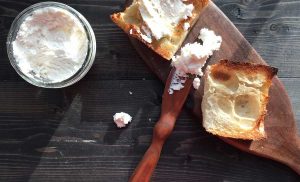 It’s cheese season. I am reminded of this because I have been out to a goat dairy farm, Prairie Fruits Farm and Creamery, bottle feeding kids, lots of them. That is of course so that the milk can be made into delicious cheese and gelato. The Land Connection’s farmer annotated calendar features cheese in March, so I thought I’d share a recipe for making chevre, the creamy, spreadable cheese a lot of people refer to as goat cheese–which is true, but it is of course only one of many kinds of goat cheese–it is also one that you can easily make in your home kitchen. And, depending on how much goat milk you get, you may want to make some goat milk caramels too.
It’s cheese season. I am reminded of this because I have been out to a goat dairy farm, Prairie Fruits Farm and Creamery, bottle feeding kids, lots of them. That is of course so that the milk can be made into delicious cheese and gelato. The Land Connection’s farmer annotated calendar features cheese in March, so I thought I’d share a recipe for making chevre, the creamy, spreadable cheese a lot of people refer to as goat cheese–which is true, but it is of course only one of many kinds of goat cheese–it is also one that you can easily make in your home kitchen. And, depending on how much goat milk you get, you may want to make some goat milk caramels too.
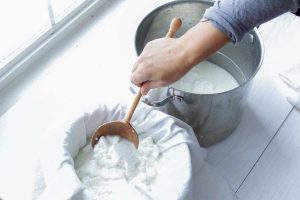 As I have been anticipating cheese season, I have also given a lot more thought about the whole process. The making of the cheese is the obvious one, but what happens to all those baby goats? Well, the answer of what happens to the does is obvious, they will either stay on the farm and become part of the milking herd, or head off to another farm for the same purpose. But what about all the bucks, what happens to them? The answer isn’t complicated, but since I, like many Americans, had never eaten goat meat, I had not given it a lot of thought. So I decided that since I am perfectly happy to eat the cheese and gelato, I should really give the meat a try too.
As I have been anticipating cheese season, I have also given a lot more thought about the whole process. The making of the cheese is the obvious one, but what happens to all those baby goats? Well, the answer of what happens to the does is obvious, they will either stay on the farm and become part of the milking herd, or head off to another farm for the same purpose. But what about all the bucks, what happens to them? The answer isn’t complicated, but since I, like many Americans, had never eaten goat meat, I had not given it a lot of thought. So I decided that since I am perfectly happy to eat the cheese and gelato, I should really give the meat a try too.
Wow. I had no idea it would be so good. I found a source of meat at a local farm (not Prairie Fruits Farm and Creamery, although there is a rumor that they will be working with a sausage maker this year) and I was surprised at how not gamey it tasted. Actually, it had a milder flavor than lamb. I imagine the age of the animal, its diet, and how it was raised was a factor in the flavor, so I would recommend finding a source that you know if you purchase any. I have made a couple of different cuts now, but I will share the recipe for the chops, and the goat milk yogurt sauce to go with them!
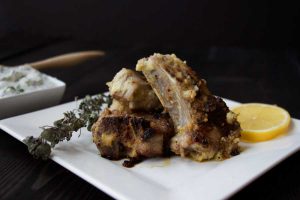 I made both the cheese and the meat dish in the span of the same couple of days, which meant I was left with a lot of whey (from the chevre making), and a pile of bones from the chops. Not wanting to waste anything, I combined the two and made what I am going to say is the very best stock I have ever made. I have also included the recipe for that here.
I made both the cheese and the meat dish in the span of the same couple of days, which meant I was left with a lot of whey (from the chevre making), and a pile of bones from the chops. Not wanting to waste anything, I combined the two and made what I am going to say is the very best stock I have ever made. I have also included the recipe for that here.
Chevre Recipe
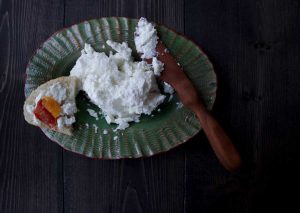 There is more than one way to make chevre. I followed the recipe that uses goat milk, culture, and rennet. This recipe and instructions were taken directly from the Cultures for Health website (you can also purchase the culture and rennet from the site). http://www.culturesforhealth.com/how-to-make-chevre/
There is more than one way to make chevre. I followed the recipe that uses goat milk, culture, and rennet. This recipe and instructions were taken directly from the Cultures for Health website (you can also purchase the culture and rennet from the site). http://www.culturesforhealth.com/how-to-make-chevre/
Ingredients
- 1 gallon goat milk
- 1/8 teaspoon bulk mesophilic culture
- 2 drops liquid animal rennet dissolved in 1/4 cup cool water
- muslin
- A large pot with a lid (if metal, be sure it’s non-reactive such as stainless steel)
- A wooden spoon
- A thermometer
Instructions
- Heat the milk to 75°F. (Please note: if using raw milk, this process will not pasteurize the milk.)
- Remove the milk from the heat and allow the mesophilic culture to dissolve on the surface of the milk for approximately 2 to 3 minutes. Once the starter culture is dissolved, thoroughly incorporate it into the milk using up-and-down strokes with your cheese spoon.
- Add the rennet mixed with water. Using up-and-down strokes (don’t stir!), incorporate the rennet into the milk. Do not over-mix.
- Cover the pot and allow the mixture to culture for 14 to 16 hours at approximately 72°F (generally kitchen room temperature).
- After 14 to 16 hours, the cheese should look like yogurt (solid if tipped but still relatively soft). You may see some whey separating from the cheese. The whey is a mostly clear liquid.
Caramel Recipe
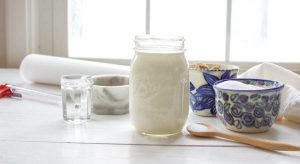 I have tried a couple of recipes for making goat milk caramel, and the one I like the best (shown below) is from the Edible Michiana website. http://ediblemichiana.com/recipes/desserts/goat-milk-caramels-with-sea-salt/
I have tried a couple of recipes for making goat milk caramel, and the one I like the best (shown below) is from the Edible Michiana website. http://ediblemichiana.com/recipes/desserts/goat-milk-caramels-with-sea-salt/
Ingredients
1 cup (or 1/2 pound) goat milk butter or regular butter
2 1/4 cups white sugar
1/2 cup brown sugar (not packed)
1/4 cup corn syrup
2 cups whole goat milk*
1 teaspoon Kosher salt
Fleur de sel (for sprinkling on the finished caramels)
Candy thermometer
Instructions
Prepare a 9- by 13-inch glass pan by buttering the bottom and sides with the wrapper from the stick of butter. Set aside on top of hot pads or a trivet.
In a medium-size, heavy-bottomed pan, place the butter,white sugar, brown sugar, corn syrup, salt and 1 cup of goat milk. Stir the mixture over medium heat until thesugars are dissolved. Bring to a rolling boil and add thesecond cup of goat milk. Place candy thermometer in the pan, making sure it is not touching the bottom of the pan as you take the temperature up to 252. Stir the mixture every 5–10 minutes to make sure it doesn’t burn on the bottom. Also watch for boilovers as it heats up. When the thermometer reaches 252, remove the pan from the heat and quickly transfer the caramel to the buttered glass dish. Allow to cool slightly and then sprinkle with the Fleur de sel. Transfer to the fridge and cut with a butter knife into 2- by 2-inch pieces. Wrap each one in waxed paper and store in the fridge.
Goat Chops Recipe
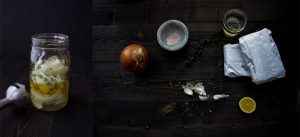 The goat chops recipe can easily be adapted using a variety of herbs and spices. I followed the recipe from the Splendid Table, and it was wonderful. http://www.splendidtable.org/recipes/grilled-goat-chops-with-garlic-oregano-and-lemon
The goat chops recipe can easily be adapted using a variety of herbs and spices. I followed the recipe from the Splendid Table, and it was wonderful. http://www.splendidtable.org/recipes/grilled-goat-chops-with-garlic-oregano-and-lemon
Ingredients
- 6 large garlic cloves
- 1 medium onion, coarsely chopped
- 1/2 cup plus 2 tablespoons good tasting extra virgin olive oil
- Shredded zest of 2 large lemons
- Juice of 1 large lemon (about 6 tablespoons)
- 1/2 cup dry white wine
- 4 teaspoons dried oregano
- 1/4 teaspoon each salt and freshly ground black pepper
- 8 to 9 1-inch thick small rib or loin goat chops (lamb could be used as well)
Instructions
1. Allow 1-1/2 to 2 hours for marinating the meat. In a food processor or blender combine the garlic, onion, 1/2 cup olive oil, the lemon zest, lemon juice, wine, oregano, salt, and pepper. Process to just short of a puree. You want some small bits of rind, onion, and garlic. Pour the marinade into a heavy plastic bag or bowl, toss with the chops and refrigerate 1-1/2 to 2 hours.
2. To cook, drain the chops but do not wipe off the marinade. Heat the remaining 2 tablespoons of oil in a 12-inch straight-sided sauté pan over medium high heat. Arrange the chops in the skillet so they barely touch. Use 2 pans if necessary. Brown quickly on both sides. Then turn down the heat to medium-low and cook another 2 minutes a side, or until the chops are barely firm when pressed with your finger. They should be blushed with pink inside. Serve the chops hot.
Stock
You can use the whey from your chevre in place of water and the bones from the goat chops to make an incredible, rich soup stock. Use any recipe for stock!
One of the things that has happened to me since I moved to the Midwest, is that I have become much more aligned with the seasons, particularly around food. It was mostly about gardening at first, but meat and dairy are seasonal too. I know that I had never considered eating goat until I spent time thinking about how the full cycle works. I am glad I did.


